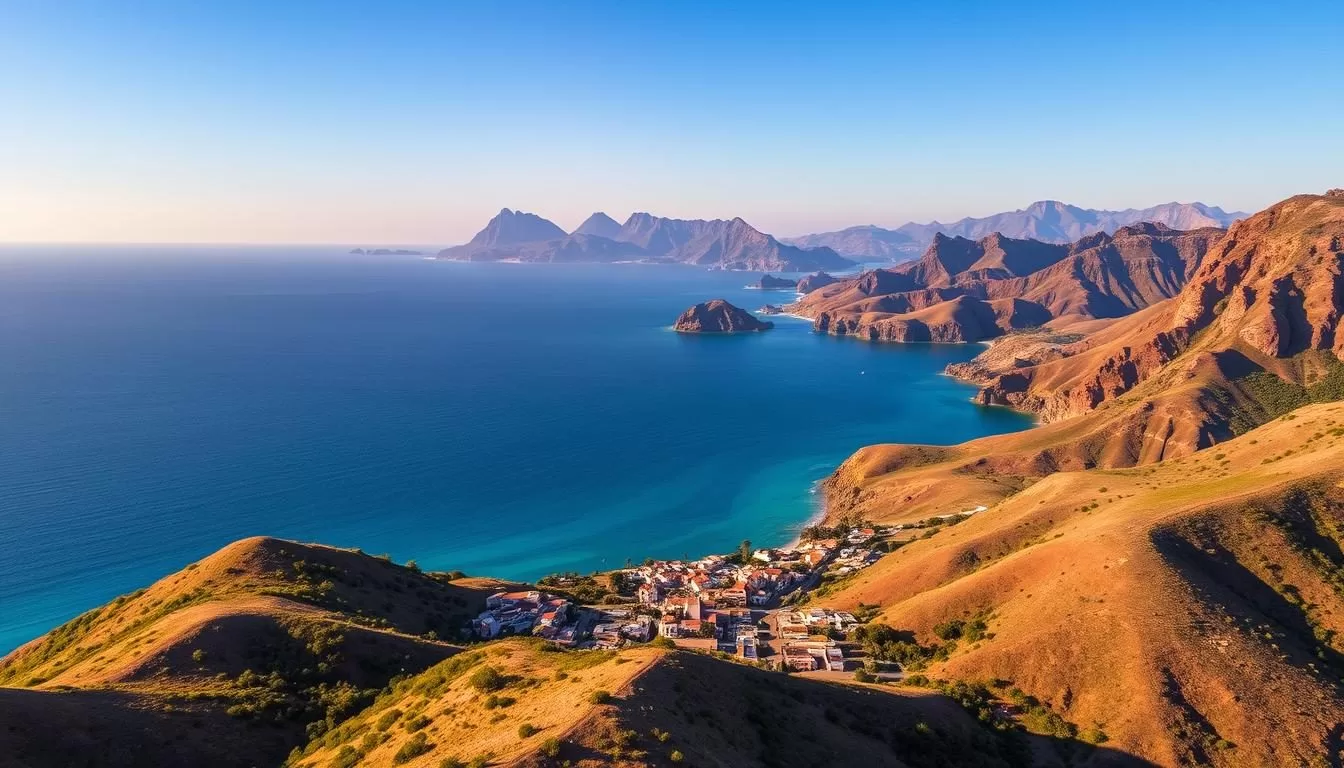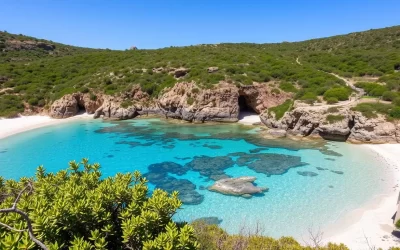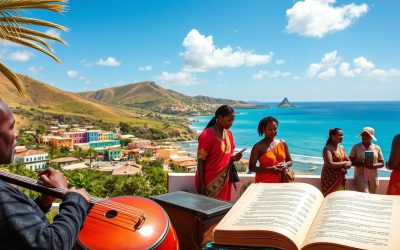✓ Accommodations✓ Flights✓ Rental Cars✓ Tours & Activities
Are you planning a trip to the beautiful archipelago of Cape Verde? With its year-round sunshine and temperatures ranging between 24-30°C, it’s an ideal destination for travelers seeking warm weather and stunning beaches.
Understanding the unique climate patterns of Cape Verde is crucial for planning the perfect trip that aligns with your preferences and activities. Each of the ten islands has its distinct charm and slightly different climate patterns, influencing your travel experience.
Whether you’re looking for ideal beach conditions, cultural festivals, or outdoor adventures, timing your visit right can significantly enhance your experience. This guide will help you determine the best time to visit Cape Verde based on weather conditions and seasonal activities.
Discovering Cape Verde’s Unique Archipelago
As you explore the Atlantic, you’ll discover Cape Verde’s enchanting archipelago. This tropical haven is characterized by its distinct climate and geography.
The Ten-Island Paradise in the Atlantic
Cape Verde is an archipelago of ten islands, each with its unique charm. The islands are divided into two groups: the windward islands and the leeward islands. The eastern islands, including Sal, Boa Vista, and Maio, are generally flatter and more arid.
The western and central islands, on the other hand, feature more varied topography and slightly higher rainfall. This diversity creates a range of microclimates across the islands.
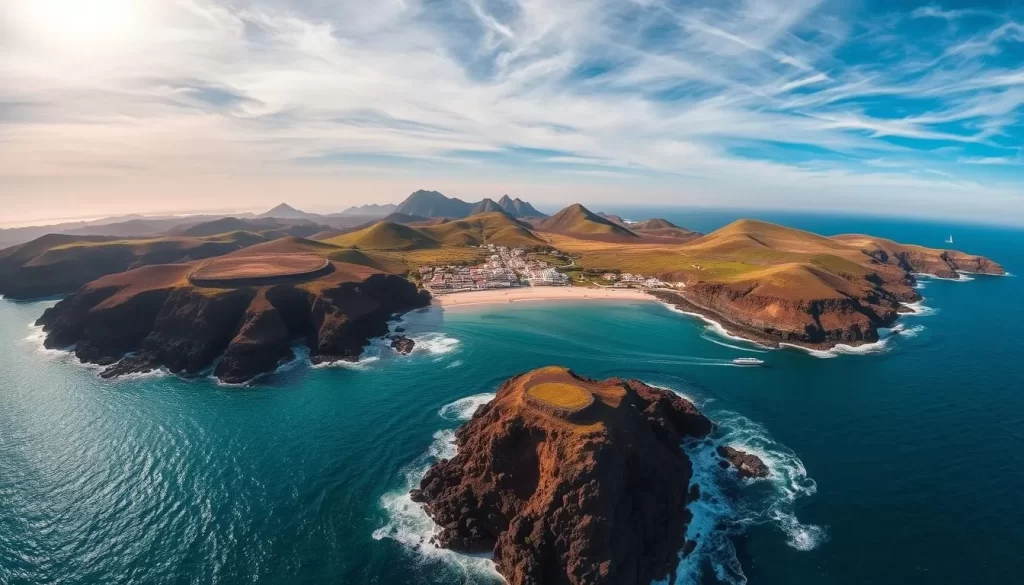
Understanding Cape Verde’s Distinct Climate
Cape Verde enjoys a unique climate characterized by year-round warm temperatures, typically ranging between 24-30°C (75-86°F). The cape verde weather is influenced by the northeast trade winds, known locally as “Tempo das Brisas,” which blow from October to mid-July.
The islands experience relatively low annual rainfall, with most precipitation occurring during a short rainy season from July to October. The dry season, which runs from December to June, is ideal for tourists seeking sunny weather.
The climate in Cape Verde is also marked by a moderating effect due to its location in the Atlantic Ocean, preventing extreme heat and maintaining pleasant temperatures throughout the year.
Cape Verde: Best Months for a Weather-Savvy Trip
Cape Verde’s unique climate means that the best time to visit depends on your preferences for weather and activities. Understanding the seasonal variations is key to planning a trip that meets your expectations.
The Dry Season: December to June
The dry season in Cape Verde, spanning from December to June, is characterized by pleasant temperatures and minimal rainfall. This period is ideal for visitors who prefer dry and sunny weather, making it perfect for outdoor activities like hiking and beach relaxation. The dry season is also a great time for water sports, as the sea temperatures are pleasant, ranging from 22°C to 24°C (72°F to 75°F).
Weather Conditions: Mild temperatures, low humidity, and plenty of sunshine.
| Month | Temperature (°C) | Rainfall (mm) |
|---|---|---|
| December | 23 | 5 |
| January | 22 | 4 |
| June | 25 | 0 |
The Rainy Season: July to November
The rainy season, from July to November, brings a different landscape to Cape Verde, with lush green scenery, especially on islands like Santo Antão. Although it’s called the rainy season, the rain showers are typically brief and followed by sunshine, allowing for continued enjoyment of outdoor activities. September is usually the hottest month, making it suitable for sun-worshippers.
The transformation during the rainy season is remarkable: the islands become greener, and the sea temperatures reach their warmest, up to 26°C (79°F), making it excellent for swimming and water activities.
- The rainy season runs from July to November, with September experiencing the highest rainfall.
- Rainfall is relatively modest, with brief, heavy downpours rather than persistent drizzle.
- The landscape transforms, especially on mountainous islands, creating lush scenery.

Weather Breakdown: Month-by-Month Guide
The archipelago of Cape Verde experiences a range of weather conditions, making it vital to plan according to the month. Understanding the weather patterns month by month can help you make the most of your trip.
Winter Months: December to February
During the winter months, Cape Verde enjoys a dry and pleasant climate, making it an ideal time to visit. Temperatures are mild, ranging from 23°C to 25°C (73°F to 77°F), and the risk of rainfall is low. It’s a great time for outdoor activities like hiking and exploring the islands.
Spring Months: March to May
As spring arrives, the weather in Cape Verde remains pleasant, with temperatures gradually warming up. It’s an excellent time for water sports, with sea temperatures becoming more inviting. March to May is also a good period for cultural events and festivals.
Summer Months: June to August
Summer brings warmer temperatures to Cape Verde, with July and August being the hottest months. Although it’s the start of the rainy season, the rain showers are often short-lived. Sea temperatures are warm, making it perfect for swimming and diving.
Fall Months: September to November
The fall months in Cape Verde are characterized by high temperatures and significant rainfall, especially in September, which is both the hottest and wettest month. However, October and November mark a transition towards drier and slightly cooler conditions, making them ideal for water activities.
| Month | Temperature (°C) | Rainfall |
|---|---|---|
| September | 30 | High |
| October | 28 | Moderate |
| November | 26 | Low |
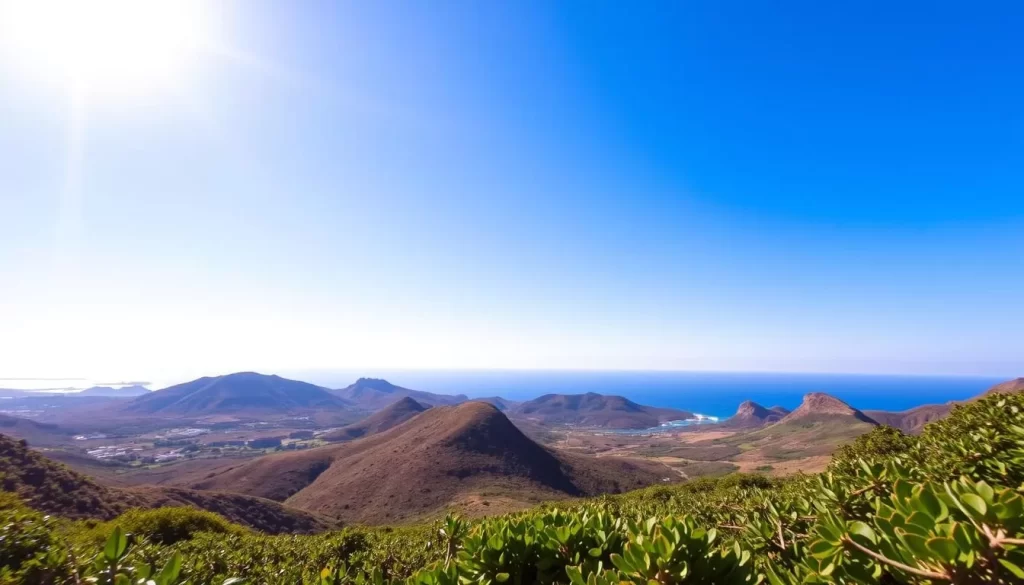
By understanding the month-by-month weather breakdown, you can plan your trip to Cape Verde more effectively, ensuring that you make the most of your time on these beautiful islands.
Island-Specific Weather Considerations
Understanding the weather variations across Cape Verde’s islands is crucial for planning your trip. The diverse geography of the archipelago results in different climate conditions across its islands.
Sal and Boa Vista: The Beach Destinations
Sal and Boa Vista are known for their beautiful beaches and dry desert climate. These islands are ideal for travelers seeking sun-kissed destinations with minimal rainfall. The dry season, from December to June, is the best time to visit these islands, offering perfect conditions for beach activities and water sports.
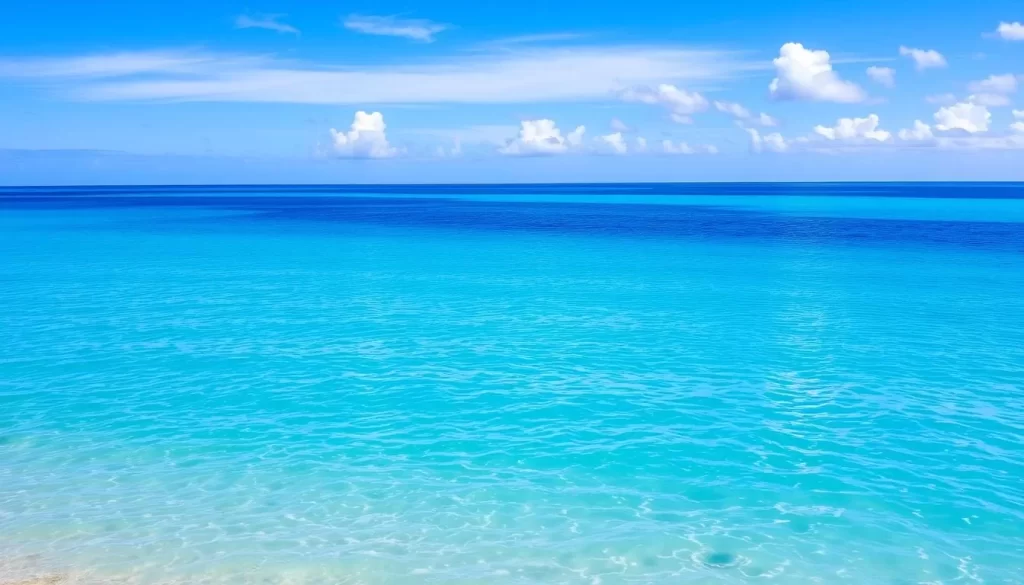
Santo Antão and São Vicente: The Cultural Hubs
Santo Antão and São Vicente offer a different Cape Verde experience, with their mountainous terrain, lush valleys, and vibrant cultural scenes. São Vicente, particularly its main city Mindelo, is known for its rich cultural heritage and music scene, hosting the famous Creole Carnival. The weather on these islands is moderated by their topography, with slightly cooler temperatures and more variable microclimates.
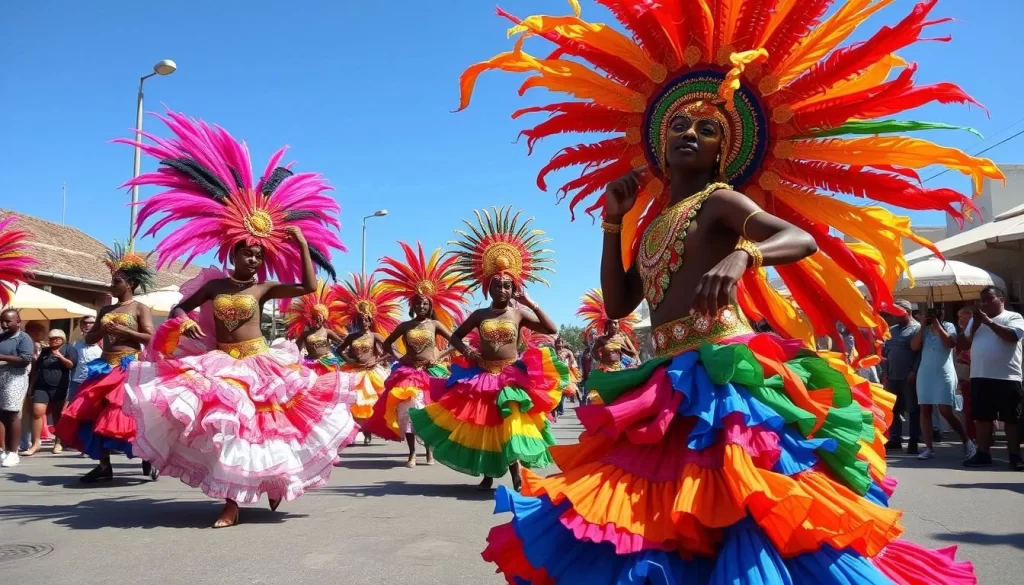
The western islands of Santo Antão and São Vicente receive more rainfall than Sal and Boa Vista, especially during the July-November rainy season. This transforms Santo Antão into a lush, green paradise ideal for hiking and nature photography. In contrast, São Vicente’s cultural events, like the Creole Carnival, take place during the dry season, making it a great time to experience the local culture and music.
Seasonal Activities and Events in Cape Verde
The islands of Cape Verde are alive with seasonal activities and vibrant events that cater to various interests. Whether you’re looking for cultural experiences, adventure, or simply a chance to relax, Cape Verde has something to offer throughout the year.
Carnival Season: January to March
Cape Verde’s carnival season is a spectacle not to be missed, typically taking place between January and March. The islands come alive with colorful parades, music, and dancing. Sal and São Vicente are particularly known for their lively celebrations, offering a unique blend of African, Portuguese, and Brazilian influences. You can immerse yourself in the local culture by participating in or simply enjoying the festivities.
Water Sports Paradise: December to June
From December to June, Cape Verde transforms into a water sports enthusiast’s paradise. The dry season brings consistent winds and calm seas, making it ideal for surfing, kitesurfing, and windsurfing. The islands of Sal and Boa Vista are popular destinations for these activities, with their clear waters and reliable wind conditions. You can enjoy a variety of water sports, or simply relax on the beautiful beaches.
Whale Watching: March to May
Between March and May, Cape Verde offers excellent opportunities for whale watching. The waters around the islands are home to a variety of marine life, including humpback whales that migrate to the area during this period. You can take a guided tour to witness these magnificent creatures up close, creating an unforgettable experience.
Hiking and Nature: August to October
The rainy season from August to October brings a lush, green landscape to Cape Verde’s mountainous islands, particularly Santo Antão, Santiago, and Fogo. This period is perfect for hiking and nature exploration, as the islands are at their most verdant. Some of the key attractions during this time include:
- The dramatic valleys and terraced farms of Santo Antão, showcasing vibrant vegetation and flowing streams.
- The visual contrast between the verdant mountains and the blue Atlantic Ocean, creating stunning landscapes.
- The opportunity to see endemic plant species blooming across the mountainous terrain.
Keep in mind that some hiking trails may become muddy or temporarily inaccessible after heavy rains, so flexibility in planning and appropriate footwear are essential.
| Activity | Best Time | Popular Islands |
|---|---|---|
| Carnival | January to March | Sal, São Vicente |
| Water Sports | December to June | Sal, Boa Vista |
| Whale Watching | March to May | Various |
| Hiking and Nature | August to October | Santo Antão, Santiago, Fogo |
Budget-Friendly Travel: When to Find the Best Deals
Traveling to Cape Verde on a budget requires some planning, but with the right timing, you can enjoy significant savings. Understanding the seasonal dynamics of this island nation is key to securing the best deals on your trip.
Shoulder Season Savings: Early July, November, and Early December
Visiting Cape Verde during the shoulder season can be a cost-effective strategy. Early July, November, and early December are periods when prices tend to be lower due to the transition between peak and off-peak seasons. During these times, you can find discounts on accommodations and packages, making your trip more affordable. For instance, booking a hotel in Sal or Boa Vista during these periods can result in noticeable savings.
- Enjoy lower prices for accommodations and tourist services.
- Experience the islands with fewer tourists, making for a more relaxed atmosphere.
- Take advantage of special offers and discounts on package deals.
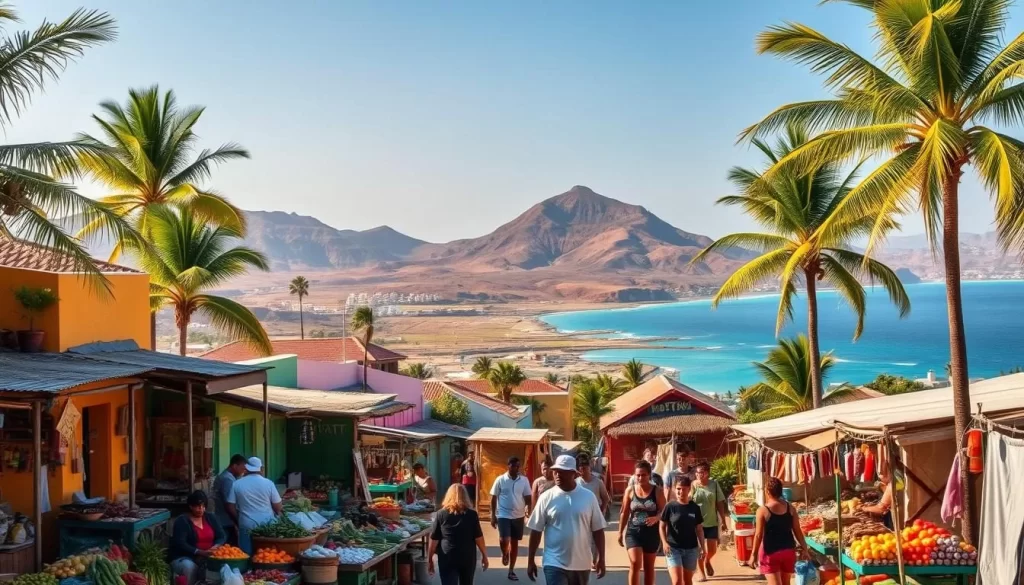
Money-Saving Tips for Any Season
Regardless of when you visit Cape Verde, there are several strategies to keep your expenses in check. Booking flights and accommodations well in advance can secure better prices, with savings often ranging from 15-25% compared to last-minute bookings. Additionally, considering all-inclusive resorts can help manage costs, as they typically cover food, drinks, and sometimes even activities.
- Opt for package deals that include flights and accommodations for better value.
- Use local currency, the Cape Verdean escudo, for smaller purchases to get better prices.
- Travel during weekdays when possible, as flights and accommodations may be cheaper.
By being mindful of your travel plans and preferences, you can enjoy a cost-effective trip to Cape Verde while still experiencing all that the islands have to offer.
Planning Your Perfect Cape Verde Trip
As you plan your trip to Cape Verde, consider the diverse experiences the archipelago has to offer. Cape Verde is a destination that truly has it all—stunning beaches, vibrant culture, and year-round sunshine. Whether you’re visiting for the lively Carnival atmosphere, exploring lush valleys, or simply relaxing by the ocean, there’s a perfect time and place for everyone.
When deciding on the best time to visit Cape Verde, think about what matters most to you. Are you looking for ideal beach weather, cultural festivals, or perhaps water sports conditions? For first-time visitors, Sal and Boa Vista are great introductions to the islands, offering developed tourism infrastructure and beautiful beaches. If you’re seeking cultural immersion, consider São Vicente during Carnival season.
To truly experience the charm of Cape Verde, plan to spend at least 7-10 days in the archipelago. This allows you to explore your chosen islands without rushing, embracing the relaxed Cape Verdean pace of life. Don’t forget to consider the logistics of inter-island travel and research entry requirements well in advance.
By planning ahead and packing appropriately for your chosen season and activities, you’ll be well on your way to creating unforgettable memories in this island paradise. With its warm hospitality and endless adventures, Cape Verde guarantees a trip you’ll cherish forever.
The above is subject to change.
Check back often to TRAVEL.COM for the latest travel tips and deals.
